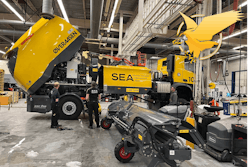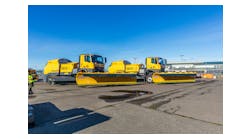Airport operations rely heavily on the efficiency and reliability of airfield equipment. From runway sweepers to operations vehicles, these critical assets play a crucial role in ensuring safe and smooth operations. To maximize equipment performance and minimize downtime, airport managers need to establish robust maintenance and repair practices.
One effective solution is to consider purchasing a Maintenance Repair Program from airfield equipment dealers.
When considering the purchase of a Maintenance Repair Program from airfield equipment dealers, airport managers should assess the criticality of equipment, evaluate the cost of downtime, analyze in-house maintenance capabilities, plan their budgets and consider warranty coverage. A maintenance repair program can enhance operational efficiency, reduce downtime and provide peace of mind by offering professional maintenance and repair services, access to spare parts, and technical expertise.
Equipment Criticality
The first aspect to evaluate when contemplating a Maintenance Repair Program is the criticality of the equipment in question. Some assets, such as deicing equipment, are vital for maintaining safe operations. If failure or prolonged downtime of these assets can significantly impact flight schedules or compromise safety, a Maintenance Repair Program becomes a crucial investment. By partnering with an airfield equipment dealer to provide regular maintenance, prompt repairs, and quick access to spare parts, airport managers can minimize equipment failures and mitigate potential disruptions.
Team Eagle General Manager Joe McKeown said in a Maintenance Repair Program, an airfield equipment dealer might make sure that one of the more essential pieces of equipment to operations is always on standby in case one goes down.
“Aircraft firefighting trucks, because they can't have them down for a certain period of time otherwise they have to close the airport. To help airports with downtime is having a piece of equipment whether it be snow equipment, ARFF equipment, or anything located in a central place for multiple airports, so they can all agree and pay into a standby fee for this piece of equipment that’s sitting say between six airports if one of them have an issue, then they can have this piece sent to that airport until it gets fixed,” McKeown said.
Cost of Downtime
Downtime costs can have a significant impact on airport operations. When equipment fails unexpectedly, it can lead to delayed flights, unhappy passengers, and financial losses. Calculating the cost of downtime helps airport managers assess the potential return on investment of a Maintenance Repair Program. By analyzing historical data, evaluating the frequency of breakdowns and estimating the financial impact of each incident, managers can make informed decisions about the value a Maintenance Repair Program would bring to their operations. A Maintenance Repair Program can reduce downtime by implementing preventive maintenance measures and providing prompt repair services, thereby offsetting the associated costs.
"The better program that you get into that you can manage, you can schedule, you can watch, you're going to keep your fleet in good working order so that way you don't have equipment that goes down and you're not having delays,” said Fortbrand Services Director Dean Schwabish.
Maintenance Repair Programs can look different depending upon how the deal is structured, what a dealer is capable or comfortable with committing to and what needs should be prioritized.
McKeown gave an example of what a deal could like look that helps minimalize downtime, “If you were going into a repair program with a local dealer like us maybe you have it so that there's only allowed to be so much downtime, which would require us to hold stock of any big crucial components or parts that could go down or even any agreement. … So, if they were in an agreement with us and they had a piece of equipment go down and it was going to be down for more than two weeks, we will try and send them another piece of equipment to use until they're back up and running. So that would have less downtime and less closure to smaller airports.”
In-House Maintenance Capabilities
Consider the existing in-house maintenance capabilities of your airport. If your maintenance team lacks specialized expertise or the necessary resources to efficiently handle airfield equipment repairs and maintenance, partnering with an airfield equipment dealer through a Maintenance Repair Program can be advantageous. These programs often offer access to trained technicians, specialized tools and extensive knowledge of the equipment. By leveraging the expertise and resources of the dealer, airport managers can optimize maintenance operations, improve equipment performance and increase the lifespan of their assets.
McKeown said it’s important to take into consideration the capabilities of your techs on staff.
“If you have a high turnaround and it costs a lot of money to get techs trained up, and get familiar with this type of specialized equipment, it might make sense to find a local dealer who's better at or has techs that have been there for years and they're not having people in and out the door so that they can service the equipment for you and keep that training rather than having to rehire and train a tech after tech,” McKeown said.
Budget Considerations
Investing in a Maintenance Repair Program requires careful financial planning. While the upfront costs may seem significant, it's essential to consider the long-term benefits and potential cost savings. A Maintenance Repair Program typically involves an annual or monthly fee that covers preventive maintenance, repairs and access to spare parts. By budgeting for these recurring expenses, airport managers can ensure predictable costs and eliminate the risk of unexpected maintenance bills. A Maintenance Repair Program can help extend the lifespan of equipment, reducing the need for frequent replacements and capital expenditures.
“I like to compare it to your own automobile. You wouldn’t get on the road, if your brakes weren’t in good working condition or your tires were bald,” Schwabish said. “In the end it’s a safety issue and will cost you more, the longer you wait.”
Warranty Coverage
Evaluate the warranty coverage of the airfield equipment currently in use. If the warranty is limited or has expired, a Maintenance Repair Program can serve as an effective means of safeguarding the equipment investment. With a Maintenance Repair Program, airport managers can enjoy extended warranty coverage, ensuring comprehensive protection against unexpected repairs and replacement costs. By entrusting the maintenance and repairs to authorized technicians from the equipment dealer, managers can also mitigate potential issues that might arise from unauthorized repairs or the use of incompatible spare parts.
“Saving money, less delays, yes, that’s important, however, the takeaway from all of this is safety,” Schwabish said. “Whether you have your own program or elect to have a third party manage your preventative maintenance, safety should be everyone’s number one concern.”


